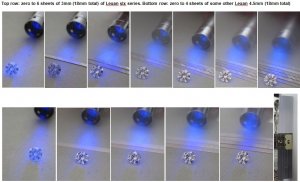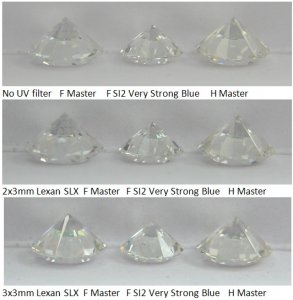- Joined
- Aug 4, 2008
- Messages
- 15,759
Date: 4/7/2010 11:16:36 AM
Author: michaelgem
Date: 4/7/2010 1:11:07 AM
Author: Karl_K
Lexan® XL sheet has a coextruded UV resistant surface treatment applied to one side to protect the Lexan against UV degradation (yellowing)Date: 4/6/2010 2:39:36 AM
Author: kenny
I wonder if it works in both directions but if sun is allowed to beat on the wrong side it loses its effectiveness after some time.
Or maybe, like you said Garry, there is some coating on one side.
There must be some reason they instruct us to have the light source face a certain side.
Bare lexan by itself blocks some UV ranges better than others.
Bare lexan is about 85% effective on short wave UV but long wave uv its less than 70% at the most, some sources say less than 25% is blocked. My guess is it depends on the wave length with near visible having little reduction.
The coated ones like the XL are rated at 92% for both long and short wave UV.
The very high end coated lexan as well as the best grades of tempered coated framing glass is rated at 99% for both long and short wave.
Karl,
This is new information that I was not aware of. It makes sense that if the primary UV filtering is accomplished by a coextruded surface treatment, that surface should face the sun to protect the Lexan, which does slowly yellow with UV exposure over time.
I am interested in your findings, as all the information I have come across so far indicates that polycarbonate plastics (Lexan and Makrolan) are opaque to UV from 385nm down. Lexan and Makrolan polycarbonate filters were used in the study when experimenting with the removal of UV from the various lighting used in grading. The attached filter curve shows polycarbonate plastic is particularly suited to removing LWUV without significant or noticeable effect on the visible light spectrum.
Using the same Home Depot Lexan pictured by Kenny, at a two inch distance in the GIA DiamondLite I measured a drop in UV from 170 uW/cm2 to a negligible amount around 1 uW/cm2. Tom Tashey, Professional Gem Sciences, over ten years ago first found a much thinner sheet of Makrolan polycarbonate effectively removed the UV in the DiamondLite allowing a diamond’s true color to be seen and graded.
Although not stated by the manufacturer, perhaps the published curves are the net filter characteristics of the polycarbonate plus coating. I''d like to know. Eye doctors state that polycarbonate lens in sun glasses and prescription clear lens effectively remove all harmful UVA and UVB.
Michael D Cowing
The one pictured by Kenny is coated.
The biggest issue is that lexan is made in dozens of varieties both branded and generic.
For example:
Lexan
Lexan mr10
Lexan xl
Lexan slx series Lexan HP series
Lexan exl series
Then there is specialized versions like the ones for eyeglasses.
http://www.sabic-ip.com/gep/Plastics/en/ProductsAndServices/ProductLine/lexan.html#
Glasses are generally made of cr39 and various polycarbonate products all of which have different UV blocking capabilities.
cr39 is highly resistant to some wave lengths of UV but it is also coated in the premium products to raise it to 99.7% of all harmful UV.
Here are the lexan versions used for eyeglasses, again you see varying amounts of UV blocking:
http://www.sabic-ip.com/gep/Plastics/en/ProductsAndServices/PerformanceProperties/opticalquality_lexan.html








300x240.png)